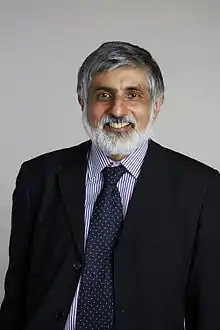Philip Maini
Philip Kumar Maini (born 16 October 1959 in Magherafelt, Northern Ireland) is a Northern Irish mathematician. Since 1998, he has been the Professor of Mathematical Biology at the University of Oxford and is the head of the Centre for Mathematical Biology in the Mathematical Institute.[3][6][7][8][9]
Philip Maini | |
|---|---|
 Philip Maini in 2015 | |
| Born | Philip Kumar Maini 16 October 1959[1] |
| Nationality | British |
| Alma mater | University of Oxford (BA, PhD) |
| Awards |
|
| Scientific career | |
| Fields |
|
| Institutions | |
| Thesis | On mechanochemical models for morphogenetic pattern (1985) |
| Doctoral advisor | James D. Murray[4] |
| Doctoral students | |
| Website | people |
Education
Maini was educated at Rainey Endowed School[1] in County Londonderry and Balliol College, Oxford where he was awarded a BA in 1982 and a DPhil in 1985, the latter for a thesis modelling morphogenetic pattern formation supervised by James D. Murray[4][10]
Research and career
After various postdoctoral research and teaching positions at Oxford and the University of Utah, he became director of the Wolfson Centre for Mathematical Biology in 1998, then Statutory Professor in Mathematical Biology and professorial fellow of St John’s College, Oxford in 2005.[2]
Maini's research includes mathematical modelling of tumours, wound healing and embryonic pattern formation,[11] and the theoretical analysis of these models.[2][7][12] His research has been funded by the Engineering and Physical Sciences Research Council (EPSRC) and Biotechnology and Biological Sciences Research Council (BBSRC).[13] He has supervised 53 PhD students.[14]
Maini gave an invited talk at ICM 2010 in Hyderabad, speaking on "Modelling Aspects of Tumour Technology."[15]
Awards and honours
Maini was elected a Fellow of the Royal Society (FRS) in 2015.[2] His certificate of election reads:
Philip Maini's mathematical and computational modelling of spatiotemporal processes in biology and medicine has led to significant scientific advances in both. His work on biological pattern formation has led to detailed understanding of the roles of noise, domain growth and gradients in pattern generation. He has generalised the concept of gradient information and has proposed an experimentally consistent resolution of the chemotactic wave paradox. He has developed multiscale models for wound healing and for vascular tumour growth. He has thereby elucidated the underlying mechanisms by which particular growth factors reduce scar formation and has provided detailed insight into the design of combination cancer therapy.[16]
Maini was an elected member of the boards of the Society for Mathematical Biology and the European Society for Mathematical and Theoretical Biology. He is a Fellow of the Institute of Mathematics and its Applications (IMA), the Society for Industrial and Applied Mathematics (SIAM), and the Society of Biology, and is a corresponding member of the Mexican Academy of Sciences. He has held visiting positions at universities worldwide.[2]
Maini co-authored a 1997 Bellman Prize-winning paper and received a Royal Society Leverhulme Trust Senior Research Fellowship and Wolfson Research Merit Award, and the London Mathematical Society Naylor Prize.[2]
References
- "MAINI, Prof. Philip Kumar". Who's Who. ukwhoswho.com. 2016 (online Oxford University Press ed.). A & C Black, an imprint of Bloomsbury Publishing plc. (subscription or UK public library membership required) (subscription required)
- "Professor Philip Maini FRS". Royal Society. London. Archived from the original on 17 November 2015. One or more of the preceding sentences incorporates text from the royalsociety.org website where:
“All text published under the heading 'Biography' on Fellow profile pages is available under Creative Commons Attribution 4.0 International License.” --Royal Society Terms, conditions and policies at the Wayback Machine (archived 25 September 2015)
- Philip Maini publications indexed by Google Scholar
- Philip Maini at the Mathematics Genealogy Project
- Schnell, Santiago (2002). On the quasi-steady-state approxiamation : coenzyme-substrate reactions as a case study (DPhil thesis). University of Oxford.
- Maini, Philip. "Philip Maini Biographical information". University of Oxford. Archived from the original on 5 September 2015. Retrieved 10 September 2013.
- Philip Maini's publications indexed by the Scopus bibliographic database. (subscription required)
- Prof. Philip Maini: Turing's Theory of Developmental Pattern Formation on YouTube
- Philip K. Maini, "Modelling collective cell motion" on YouTube
- Maini, Philip Kumar (1985). On mechano-chemical models for morphogenetic pattern formation (DPhil thesis). University of Oxford.
- Collier, Joanne R.; Monk, Nicholas A.M.; Maini, Philip K.; Lewis, Julian H. (1996). "Pattern Formation by Lateral Inhibition with Feedback: a Mathematical Model of Delta-Notch Intercellular Signalling". Journal of Theoretical Biology. 183 (4): 429–446. doi:10.1006/jtbi.1996.0233. ISSN 0022-5193. PMID 9015458.
- Plikus, Maksim V.; Mayer, Julie Ann; de la Cruz, Damon; Baker, Ruth E.; Maini, Philip K.; Maxson, Robert; Chuong, Cheng-Ming (2008). "Cyclic dermal BMP signalling regulates stem cell activation during hair regeneration". Nature. 451 (7176): 340–344. doi:10.1038/nature06457. ISSN 0028-0836. PMC 2696201. PMID 18202659.
- "UK government grants awarded to Philip Kumar Maini". Research Councils UK. Swindon. Archived from the original on 31 December 2015.
- Philip K. Maini at the Mathematics Genealogy Project
- ICM proceedings 2010 page 3091, Vol 4
- "Certificate of election EC/2015/27: Philip Kumar Maini". Royal Society. London. Archived from the original on 23 December 2015.